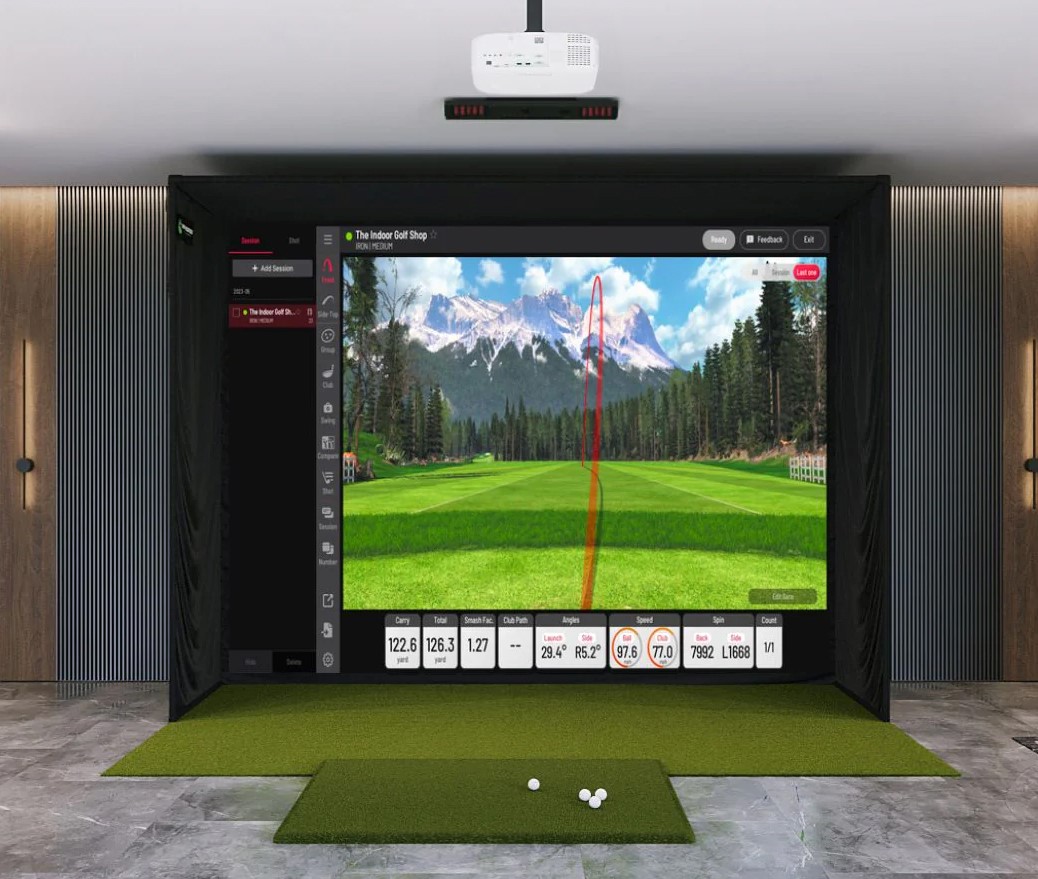As younger people, some of us dreamed of flying cars and rocket packs while those of us who could really envision a true utopian future pined for entire golf rounds without having to leave the house. Today, home golf simulators bring stunning realism to indoor golf with systems that make game improvement, family entertainment and multi-sport development the ultimate modern convenience. Companies like The Indoor Golf Shop (ShopIndoorGolf.com), the industry’s most trusted seller, distributor and even manufacturer of all the things you need to optimize the ultimate home golf room, are staying busy these days.
With the soaring popularity of indoor golf, it helps greatly that technology has quickly made the experience a lot more similar to playing outdoors and way more convenient. More and more golfers than ever are installing golf simulators in their homes. If that’s you, there are several things to be aware of ahead of time, according to Rene Delgado, founder and CEO of The Indoor Golf Shop. If you’re not the DIY type, The Indoor Golf Shop can actually send professionals to your home and take care of everything start-to-finish – with respect to measuring, installing and activating.

“One of the most common questions we get is about ceiling height,” says Delgado. “Sometimes people have nine- or 9.5-foot ceilings and ask if they can swing in this area. There’s no one-size-fits-all answer. People have different swing types and heights. So, we ask them to swing a club slowly to ascertain whether or not it’s possible.”
In fact, the overall dimensions of your potential sim room are key. Even though your room may seem wide and deep enough, remember that a sim is part of a larger enclosure that needs to fit in that space. So you may need more space than you think. Too small and you may not be able to swing the club properly.
Then there are the components to avoid skimping on. The hitting surface, for instance, needs to be durable and have good padding underneath. A typical driving range mat with little padding can be very violent on the joints. “You want to get something realistic, that has a fairway feel but is also forgiving and allows you to swing down and through effortlessly,” says Delgado.

Next, give careful thought to the launch monitor – the computer that measures your swing and allows you to play the likes of Pebble Beach in your home. If you’re looking to hit balls indoors only, consider a ceiling mounted unit that’s off the floor and out of the way. It accommodates both left- and right-handed golfers. If you’re only going to have a right-handed or left-handed golfer hitting balls in your sim, then opt for a floor-based photometric (camera) unit because you won’t have to move it like you would if you had both lefties and righties. And if you need portability and want to sometimes take the launch monitor outside to hit balls, then a Doppler-based (radar) unit might be the way to go.
Finally, take into account the projector. Delgado says if customers have any buyer’s remorse after installing a sim, it’s usually that they should’ve gone with a better projector. “You don’t have to spend a ton of money on them, either,” he says. “Switching from an $800 projector to a $2,000 projector is a night-and-day improvement with a lot more lumens, pixels per frame, and overall flexibility. A lot of customers come back later on and upgrade their projector.”
While this may all seem daunting, it’s really not – insists Delgado. “A lot of people are intimidated by the process and think it’s going to be overly complicated,” he says. “But at least with our simulator box-type solutions, everything we manufacture and design is meant to be set up and installed by a customer in under an hour. Our enclosures, our frames, are push-button connect, color coded, and very simple to put together. You can put it up within 20 minutes. One person can do it. We’ve tried to make it as easy as possible for customers to do it on their own.” And whichever company you choose to buy components from, make sure they have a support team that can help walk you through each installation step over the phone. Some can even remotely connect to your computer and calibrate the system.
Of course, you can always opt to have someone handle the entire project – at a price. “If we fly a team out to build your custom unit, then it’s a much higher-end product,” says Delgado. “Those jobs typically run $35,000 to $60,000. It’s a built in-solution where we design the setup for your specific space. We’re building the frame into the wall, integrated subfloor, everything. We design everything, show you everything in 2-D and 3-D renderings, and then you sign off. We custom manufacture everything, and then we fly out a team to do the installation.”
To learn more ways to build you dream indoor golf space, visit ShopIndoorGolf.com.








